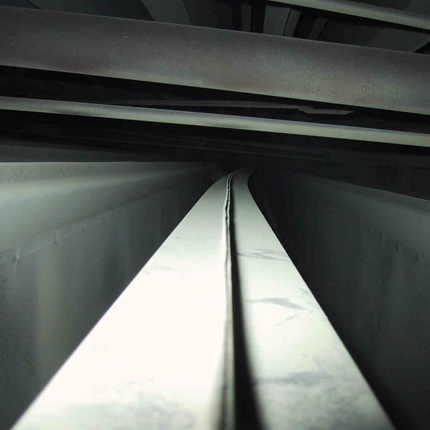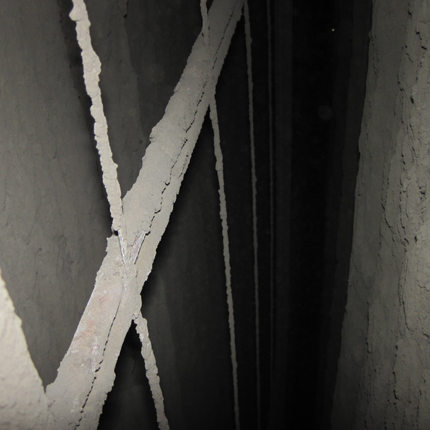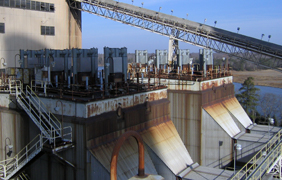Inspections & Maintenance
An effective electrostatic precipitator inspection is part of routine equipment maintenance. For example, at the municipal utilities power station in Sikeston, Missouri, precipitator blast-cleaning is done every year along with a walk-through and routine rapper tune-ups. Complete detail inspections and larger repairs are scheduled every other year during longer outages.
“By keeping up with this maintenance, and also doing a more thorough inspection every other year, we get a lot more longevity out of the run,” explains Ed Boyd, Sikeston’s electrical supervisor and project engineer, who has been in the industry for 34 years.
Any inspection, whether a quick walk-through or a more lengthy check-up, requires some legwork up front, and a plan for prioritization during and afterward. This article outlines best practices for a smooth inspection. If you’re doing the inspection yourself, treat this as a checklist. If you’re hiring a contractor, make sure these steps are part of their routine procedure.
First, clarify desired outcomes of the inspection with whoever will get a report afterward and is authorized to act on recommendations. Having a clear objective up front will save time, money and headaches later. The scope of work for a preventative maintenance (PM) inspection will be different from one focused on troubleshooting specific problems.
Next, get background information from people responsible for operating each area of the equipment (electrical, mechanical, ash handling). Ask these people if there are specific issues they’re troubleshooting. Piecing this information together will provide a picture of current operating conditions and possible problem areas. For example, electrical issues might be traceable back to hopper pluggage.
“It’s easy to get sidetracked or impatient looking for people who have this information,” notes Jim Parsons, Senior Environmental Consultant at Neundorfer, who has been doing inspections for 30 years. “But it’s worth spending the time gathering background information and clarifying expectations before jumping in the ESP box.”
Background information gathered ahead of the inspection should include original design specifications. These specs enable you to create an accurate precipitator layout form (a grid showing the location of plates, wires and other components) to mark with notes during the inspection. A layout form is especially vital if you’re inspecting a large precipitator; without a map showing where things are located, the job can be daunting.
“After a while, it’s like walking around in a cave with sunglasses on,” Parsons says. “You can easily get overwhelmed if you don’t have a clear idea of what to look for.”
With design specs, information about troubleshooting efforts, and understanding about expectations, you can effectively prioritize where to begin and what to look for during the inspection.
Before actually heading into the precipitator, of course, make sure all safety protocols–including tag-out and lock-out–are being followed. This is high-voltage equipment and not something to mess around with.
Usually, the inspection scope of work includes a standard list of maintenance items and at least a few requests to look for specific problems. At Sikeston, inspection work is prioritized first based on job tickets, such as a report of rappers not operating properly. It’s also standard practice to check for broken insulators.
“We start with anything that’s obvious from the outside,” Boyd explains. “Then, we go inside and look for anything unusual.”
Things can get pretty interesting during an inspection if you are troubleshooting specific issues, but even a routine maintenance walk-through will turn up items in one area that impact performance elsewhere and require further investigation.
“If an ash line is clogged and we find foreign material when clearing it, during the inspection we go look for where that material came from,” Boyd notes, citing one troubleshooting example. “Or, if we do a quick inspection of the high voltage area and find arcing, we know there is moisture and we need to look for leaks.”
Finally, an exit review meeting should be part of any inspection. During this meeting, give the person you’re reporting to a punch list of items that need to be addressed right away.
A punch list is different from the more detailed report you’ll submit later, which will focus on longer-term follow-up. For example, if you find bowed plates in a section of the precipitator, the punch list might recommend pulling wires in those areas to prevent electrical shorts. The longer report would specify that the plates need to be straightened or replaced.
It’s important that any inspection be performed by experienced professionals who understand how all components of the system work, know what to look for, and are informed about how to prioritize what needs maintenance immediately and what can wait.
Purpose
Internal inspections of Electrostatic Precipitator’s (ESP) are a necessary part of maintaining the œmechanical portion of the electrical to obtain maximum performance. In some instances, when performance is deemed acceptable prior to a scheduled outage, inspections often overlook specific internal areas that can detract from collection efficiency during the next on-line period of the ESP. Detailed internal inspections are required to properly schedule current and future maintenance and as a prelude to failures. The following are recommendations, generic in nature, for the conduction of an inspection that will œtime freeze the condition of the internal ESP components.
Legal Notice
CAUTION “ Inspections should only be accomplished under the direction of personnel familiar with all Electrostatic Precipitator Safety procedures. It is important that proper grounding procedures and removal of all sources of power be accomplished prior to entering the Precipitator. LETHAL VOLTAGES CAN BE PRESENT AND CAN LEAD TO DEATH BY ELECTROCUTION IF THE PROPER PROCEDURES ARE NOT FOLLOWED. Hot dust may be present on the interior surface of the ESP. These dust deposits may be cool on the surface, but the interior of the deposit may retain sufficient heat to cause SEVERE BURNS ESPECIALLY WHEN OPENING HOPPER DOORS. CONSULT YOUR PLANT’S SAFETY MANUAL FOR PROPER PROCEDURES. Neundorfer, Inc. is not responsible for any damages or injury as the result of this document and the use of the document is at the sole risk of the USER and NOT Neundorfer, Inc.
Pre-Inspection Preparation
- Take electrical readings from all High Voltage Controls (MC) at normal operating conditions.
- If possible, take a set of V-I Curves for each MVC identifying the œcorona onset voltage. (First flow of secondary current).
- Record all Rapper Control Parameters including cycle times, time between raps and intensities.
- Develop œCell Diagrams of each ESP Field showing every Collecting Electrode (CE) and Discharge Electrode (DE) with numbers on CE’s and Gas Passages (GP).
- Develop œRoof Plan Diagrams of the ESP showing the Transformer-Rectifiers (T-R), CE and DE Rappers and locations of High Voltage Support and Rapper Shaft Insulators.
- As soon as the Fuel supply is turned off (I.E. coal mills stopped, wood/wood waste feeders stopped, Black Liquor Guns pulled, etc.) Turn off the Rapper Controls.
- Leave the T-R sets on until the Fans are shutdown.
- After Fan shutdown, turn off the MVC’s.
- Remove all ash from the Hoppers.
- Follow specific owner and ESP Manufacturer instructions for Key Interlock Lock-Out and Tag-Out of the Transformer-Rectifiers.
- Follow specific owner and ESP Manufacturer instructions for entry into the Precipitator following all grounding, entry and Personal Protection Equipment (PPE) procedures.
Dirty Inspection
The purpose of the Dirty Inspection is to examine dust deposits on the ESP internals. It becomes a guide for determining the effectiveness of the Rapping System, Flue Gas Conditioning System (if equipped), Gas Flow Distribution and unusual build-up’s, etc. Dust deposits not compacted by the ESP electrical forces are often quite fragile so minimum disturbance is recommended.
- Observe dust deposits in inlet and outlet ductwork and diffusers (I.E. Nozzles and/or Plenums, etc.), gas distribution devices (such as Turning Vanes, Perforated Distribution Plates) and any other internal struts, braces, etc.
- Conduct a GP by GP inspection noting the depth of dust deposits on the CE’s and the characteristics of the particulate. (I.E. Color, Density, Muddy, Cement like, etc.) Note if deposits are more in a given area. (Measuring depths is recommended.) Inspect all lower and mid-point CE horizontal spacers and CE Alignment devices attached to the Casing.
- Inspect all DE’s noting dust deposits on the DE’s and Lower Discharge Electrode Frame (LDE). (DE deposits could be light, donuts, smooth, pointy, etc.) Examine the condition of the lower Anti-Sway insulators is so equipped, especially for carbon and tracking.
- Measure and record all CE to DE spacing.
- Look down into the hoppers and note any buildups in the corners, valley angles and baffles.
- From the inside of the Penthouse or Insulator Compartments inspect all High Voltage Support and Rapper Shaft Insulators noting dust deposits, cracked and/or tracking.
- Inspect all other High Voltage Insulators such as Standoff, Feed-Through, etc, for dust deposits and tracking.
- Inspect all Buss Ducts and High Voltage Conductors and connections.
- Observe dusting on the interior surfaces of the Penthouse or Insulator Compartments. Observe any air-in and water-in leakages.
- Open œHot Roof access doors noting gasket, hold-downs and corrosion.
- Inspect the Upper Discharge Electrode Frame (UDE) and tops of CE’s noting dust build-up and dust characteristics.
- Check the UDE Frame for vertical position from the tops of the CE’s in four locations.
- Check the High Voltage Support Insulators from the top of the UDE frame and the corona shield (if so furnished) noting any corrosion or miss-alignment of the UDE Support Rod or Pipe. Check all welds of the Support Rod/Pipe to the UDE Frame.
- Check all DE connections to the UDE Frame noting any corrosion or electrical erosion. Look for bent or twisted DE’s and bent emitter pins (Rigid Discharge Electrodes).
- At approximately the four outermost corners of the UDE Frame Measure the DE to CE Spacing in the direction and perpendicular to Gas Flow. This will determine the relative position of the UDE Frame with regard to the CE System. Place a level on the UDE frame between Support Rods/Pipes and record.
- Check all CE suspension bolts and Rapper Shaft connections to the CE’s and/or CE Suspension. Inspect all welds.
- Look for any water-in leakage and/or corrosion on the sidewalls and girders of the casing and underside of the hot roof. Pay close attention to any penetrations in the hot roof including High Voltage Support Lifting Rod Nipples and Rapper Shafts.
- From the Hopper Access Doors Inspect all internal hopper surfaces and Door Condition.
- Exhausted and dirty, clean up and take a well-deserved break while transposing notes to the Cell and Roof Plan Diagrams.
Interpretation of Dirty Inspection Results
- From the dust deposits and DE to CE Spacing recorded on the Cell Diagrams, compare these to the electrical readings taken ahead of the shutdown. Using a œrule of thumb of 10 KV/Inch of clearance between the DE’s, CE’s and other grounded surfaces a general agreement should be noted.
- DE deposits usually result in higher KV and lower MA.
- CE deposits usually result in lower KV and MA.
- Dust deposits that are found to be heaver in one part of a Field as compared to other parts dramatically detract from performance.
- Schedule maintenance/repairs from recorded non-operating Rappers.
- Re-align DE’s to CE’s to achieve the ESP Manufacturer’s Tolerances.
- Unusual dust deposits in Ductwork, Diffusers and Gas Distribution Media or œsand blasted clean indicate attention to Gas Flow Dynamics and/or Process Conditions.
- Schedule repair of corrosion and/or Access Door Gaskets to minimize air-in leakage (especially with ESP’s operating under suction).
Clean Inspection
- Prior to the inspection clean down the ESP internals in accordance with your specific Plant’s instructions. If minor or major maintenance is to be undertaken during this outage a thorough cleaning is normally required prior to work being accomplished.
- Inspect all Rappers. If external electro-magnetic style, insure Rappers are Plumb, all support rods and nuts are tight. If Pneumatic or Shaft Mounted electro-magnetic style, check Rappers for Plumb. If Vibrators, check all attachment bolts and nuts. If internal rapping system check all hammers for wear, side-to-side motion and the strike anvils.
- Check all boot seals/stuffing boxes and ground connections on ESP’s with External Rapping Systems.
- Check stuffing boxes and external drives/motors on ESP’s with Internal Rapping Systems.
- Run the Rappers at least one full cycle and observe rapping action. Measure lifts where Rapper plungers are visible (electro-magnetic styles).
- Check the Purge Air System fan and dampers. Operate briefly to determine damper operation, if so equipped. Ohm check Blast Heaters, if so equipped. (Some ESP’s are equipped with Calrod Heaters at the Base of the HV Support Insulators.)
- Check all key interlocks for ease of operation, chains and/or mounts, transfer blocks, etc.
- Check all Transformer-Rectifiers (T-R) noting any dielectric fluid leaks, tank hold-downs and grounding. Record nameplate data. Open the 480 V JB and check the surge arrestors.
- Open up the T-R buss duct inspection covers and check all insulators and HV conductors noting any dust, corrosion and or evidence of sparking.
- Check the Penthouse or Insulator Compartment Access Doors for gasket resilience, hold-downs and corrosion.
- Inspect all Grounding Sticks and connections.
- From the underside of the Hot Roof re-inspect all UDE Frames, DE’s, CE Suspension and Rapper Rod connections. Check for corrosion especially under each HV Support Insulator.
- Inspect all Side Access Doors for gaskets, hold-downs and corrosion. Check all key interlocks. (Not all ESP’s have Side Access Doors)
- Inspect all Grounding Sticks outside of the Side Access Doors is so equipped.
- Re-Inspect all internal components from the Side Access Doors and or the Hoppers. Spot measure again all DE to CE Clearances. Check all CE alignment devices. Check for corrosion everywhere.
- Inspect Hopper Access Doors, gaskets, and key interlocks.
- Check Hopper Vibrators (if so equipped) and operate.
- Check all hopper poke holes and caps.
- Ohm check hopper heaters.
- Re-Inspect all ductwork, diffusers and gas distribution devices. Look for corrosion.
- Inspect all control cabinets.
- Exhausted again, clean up and transpose all notes to the Diagrams.
Post Inspection
- If internal Repairs were made, megger each Electrical Buss Section, after disconnecting the HV lead, to check for dead shorts.
- Lock out the ESP following the Plant’s procedures.
- Operate the Purge Air System and Heaters for a minimum of 1 hour prior to turning on the T-R Sets.
- Turn on the AHVC’s, one-at-a-time with Secondary KV settings at 20 to 25 KV. Observe readings. Troubleshoot as required. Raise the Secondary KV to the normal setting. A secondary limit of KV or MA should be reached without sparking. Troubleshoot at required.
- Run V-I curves for each set noting the Corona Onset Voltage. Compare with the one’s taken prior to the outage.
- Record all AHVC Parameters/Settings. Tune each set as required to match the internal conditions of the ESP.
- Review Rapper Control Parameters/Settings. Adjust as required.
- After Process Stabilization, take V-I Curves and compare with those taken just before startup.
- Take V-I Curves after approximately 1 month of operation and compare with those taken just before the outage.
Electrostatic Precipitator Outage Startup Best Practices
Prior to an outage, be sure to record a set of benchmark T/R readings, and particularly for a major outage, a set of V/I curves as well. Then, plan to run a set of post-outage readings, once the unit is up and running normally, for comparison.
By recording T/R readings even for short outages, you will be able to see potential areas that need attention during this outage or the next one. You may also be able to address an issue that could have caused you to reduce process production if left unattended.
The V/I curves provide a benchmark of clearance issues in the box and show which T/R’s are functioning properly versus those that need to be addressed. V/I curves will also help show the effects of other performance factors such as coal and temperature changes.
Helpful Resources
KnowledgeBase: Theory of Operations
KnowledgeBase: Equipment Improvements
Our Capabilities: Performance-Based Maintenance
Our Capabilities: Equipment Assessments & Inspections





